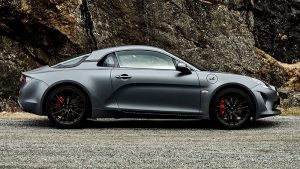Sharon Stone, Richard Gere, and Roger Moore drove a Lotus Esprit in a blockbuster Hollywood movie
Lotus Esprit won generations of admirers in Basic Instinct, Pretty Woman, and, especially, in Moore’s The Spy Who Loved Me, when James Bond drove a white Lotus Esprit Series 1 in an epic chase along the Sardinian coast and then transformed it into a torpedo-firing submarine when he took it underwater.

The Esprit premiered in 1972 as a conceptual exercise. By 1976 the production version arrived—looking thrillingly like the original concept, a rarity especially in that era for automakers. The Italian designer Giorgetto Giugiaro (of Maserati Ghibli, DeLorean, BMW M1, and De Tomaso Mangusta fame) created the Esprit body style

Inside, the cockpit came with two seats set so low you could tumble right in and a dashboard curved around the driver on either side, like a console that a filmmaker in the ’70s would imagine to be a spaceship of the future. There’s not much head, shoulder, or leg space. There’s virtually no visibility from the driver’s seat out the rear side and back windows, though some variants now include a clear cover over the back so you can see the engine without popping the hatch.

Lotus engineers added a 2.0-liter, four-cylinder engine “under the hood” as it were, though in actuality the engine was placed to the rear middle of the car, set just behind its only two seats. It came with a short-shifting five-speed manual transmission. Optimistic readings of the power output came in around 150 horsepower.

The car weighs 2,200 pounds, so that amount of power is enough to get it up to decent speed, and it excels around corners. Overall, the nimble handling and light ride (if not its pure power) match its polygonal good looks. It handles hills and winding roads with the grace of a skier. In good working order, its four cylinders make a signature warbling engine sound unlike anything else.

When the 1980 Esprit Essex Turbo was launched, it took performance on a much higher playing field. With 210 hp on tap, the Essex Turbo could cover the 0 to 100 km/h sprint in just 5.6 seconds, and top speed was now about 250 km/h. The Essex Turbo proved so popular, that from then on, the forced-induction Esprit was the one to have, and Lotus would eventually stop producing the naturally-aspirated model by the end of the decade.
The 1976 Lotus Esprit coupe used in The Spy Who Loved Me (1977)


The vehicle is one of two Lotuses driven in the film by Roger Moore’s James Bond character. It turns into an amphibious car for the movie, driven both on land and underwater.

Esprit model from the James Bond movie For Your Eyes Only (1981)

In 1986 Lotus was sold to General Motors. The American auto giant however had no idea what to do with a niche British sports car company, and while it helped develop and launch the second-generation Lotus Elan model, it hadn’t done enough for the flagship Esprit. After a few profitless years, GM wanted to step away from Lotus, and search was under way to find it a new caretaker. This got the attention of a suave Italian businessman – Romano Artioli – who came to its rescue.

At the time of the take over, Lotus was developing some new variants for the Esprit, and Artioli wasted no time in bringing them to market. First among which were the Esprit S4 and the Esprit Sport 300 (both models first appeared in 1993).

The S4 was the pretty one, which was penned by Julian Thompson – a talented designer. The Sport 300 was the aggressive one – featuring wider wheel arches, race tuned suspension, as well as a stiffer chassis to improve the cars’ already impressive handling. Oh, and one more thing, the Sport 300 had more power too. While the Esprit S4 offered 264 hp (which is plenty to move its 1,320 kg of mass), the Esprit Sport 300 was tuned to produce 302 hp from the same 2.2L turbocharged four-cylinder motor. IMG_2584The Sport 300 was also lighter, tipping the scales at just 1,243 kg. All this helped make it one of the fastest Esprit models ever put into production, with the 0 to 100 km/h dash covered in 4.7 seconds, and a top speed of about 270 km/h. With just 64 examples ever made, it is one of the most collectable Esprit models ever put into production.
Share this:
- Click to share on Facebook (Opens in new window)
- Click to share on Twitter (Opens in new window)
- Click to print (Opens in new window)
- Click to share on LinkedIn (Opens in new window)
- Click to share on Reddit (Opens in new window)
- Click to share on Tumblr (Opens in new window)
- Click to share on Pinterest (Opens in new window)
- Click to share on Pocket (Opens in new window)
- Click to share on Telegram (Opens in new window)
- Click to share on WhatsApp (Opens in new window)





Pingback: Cybertruck Is Inspired By A Spy Car | Welcome to the 007 World!